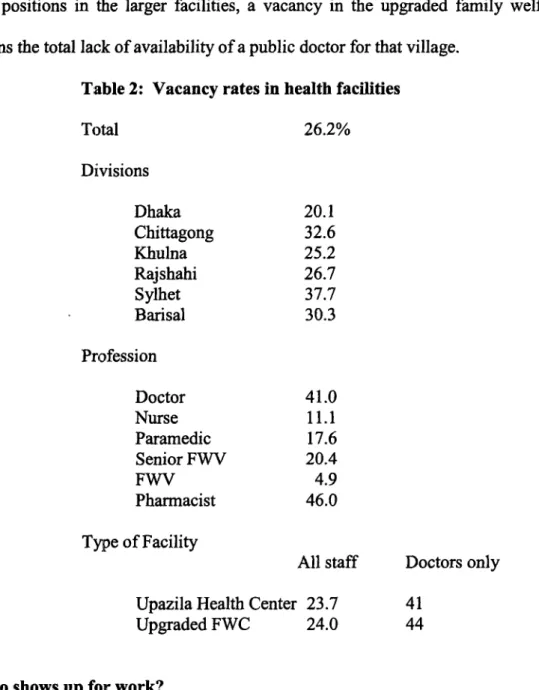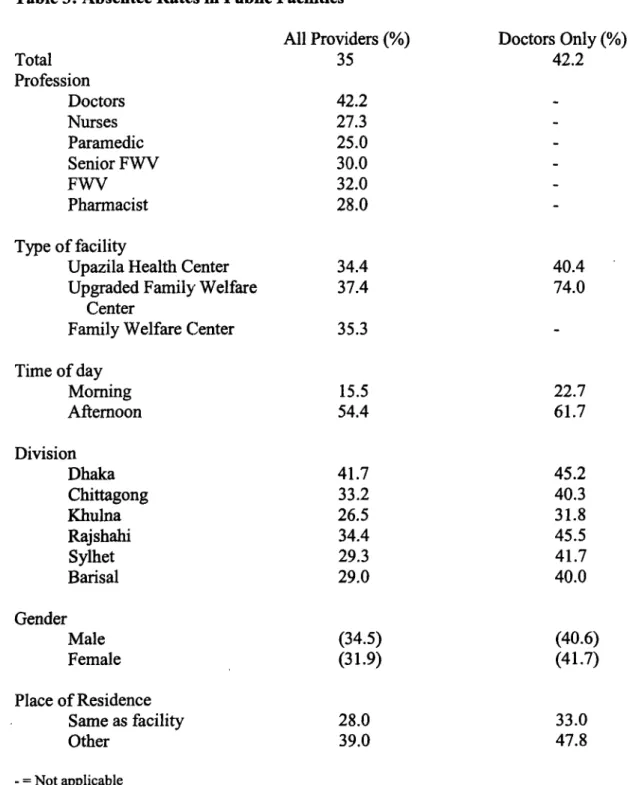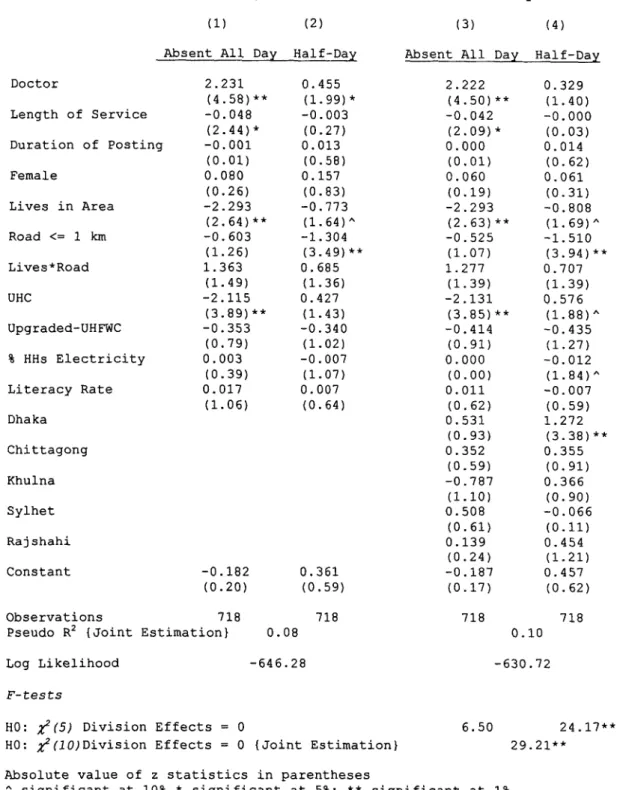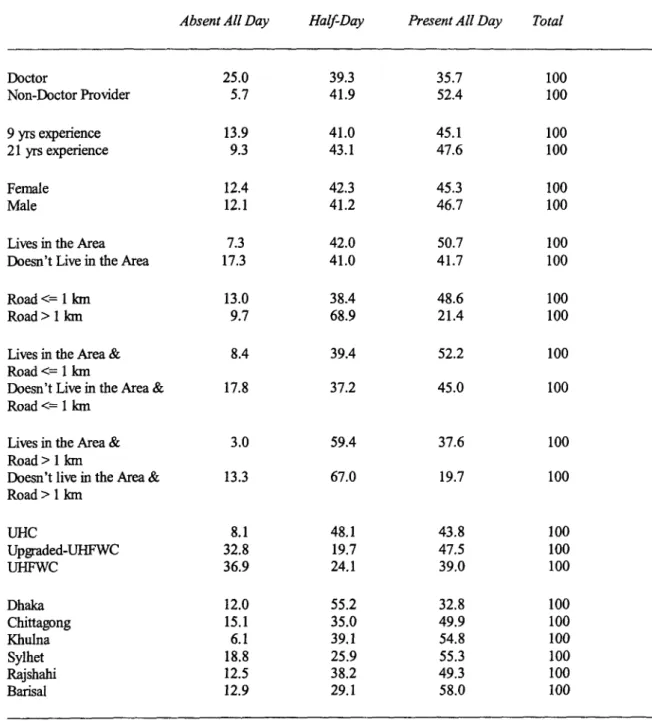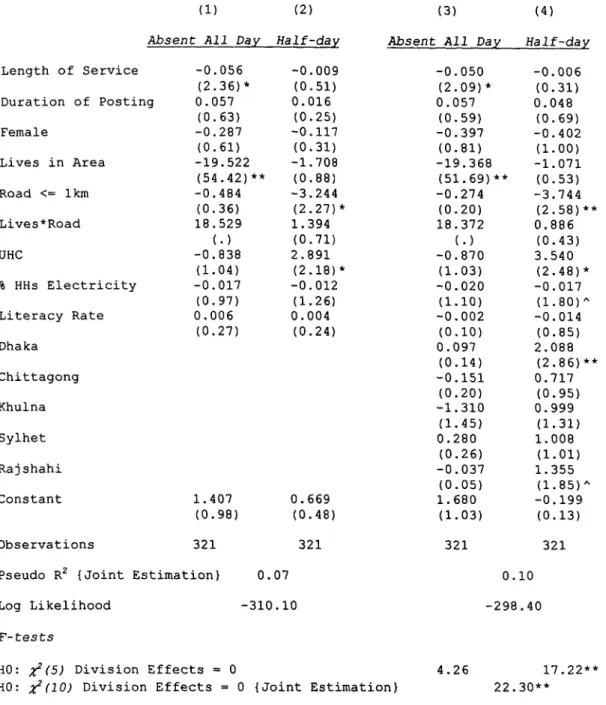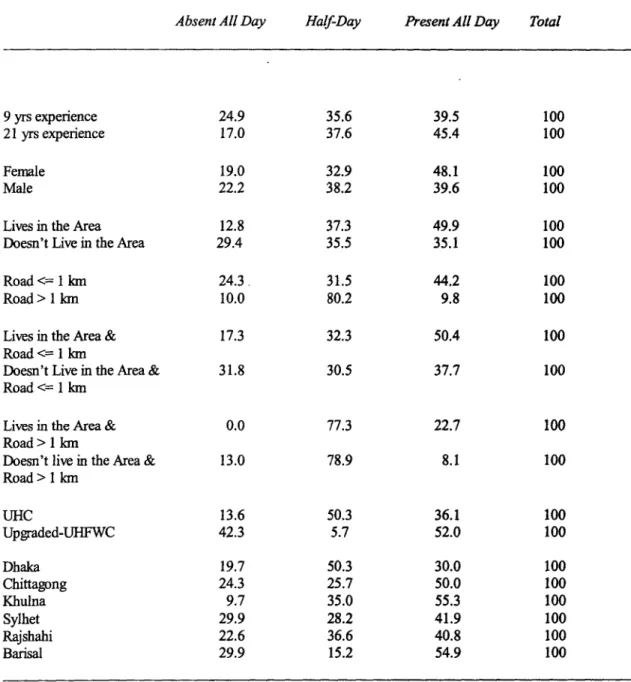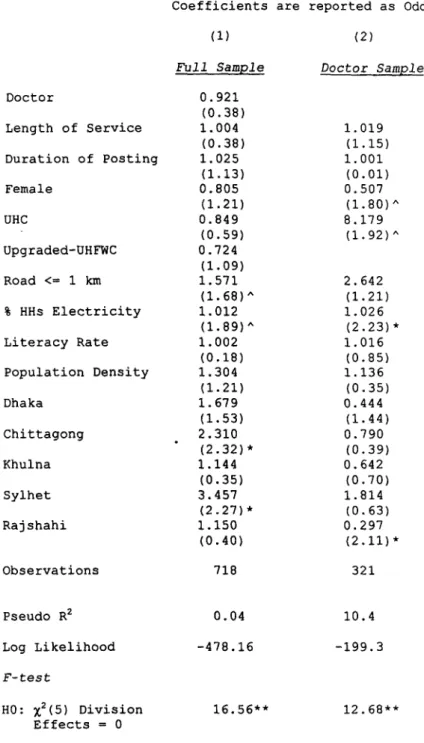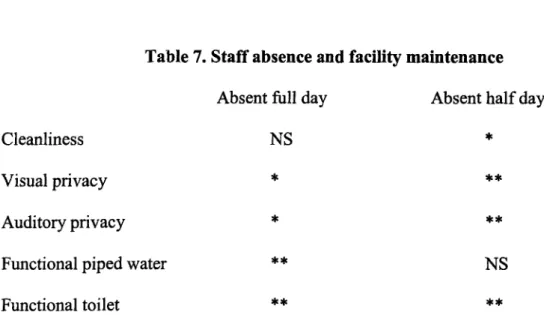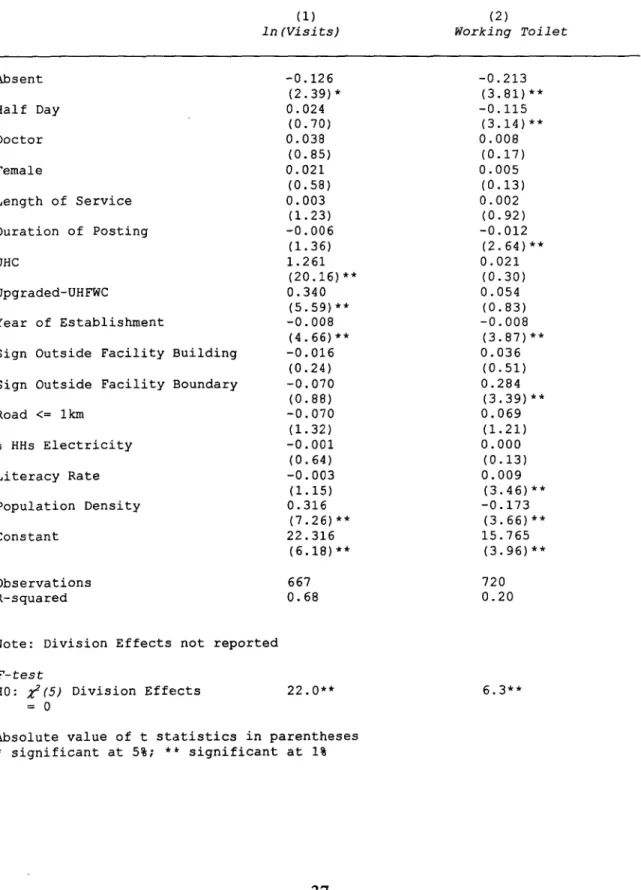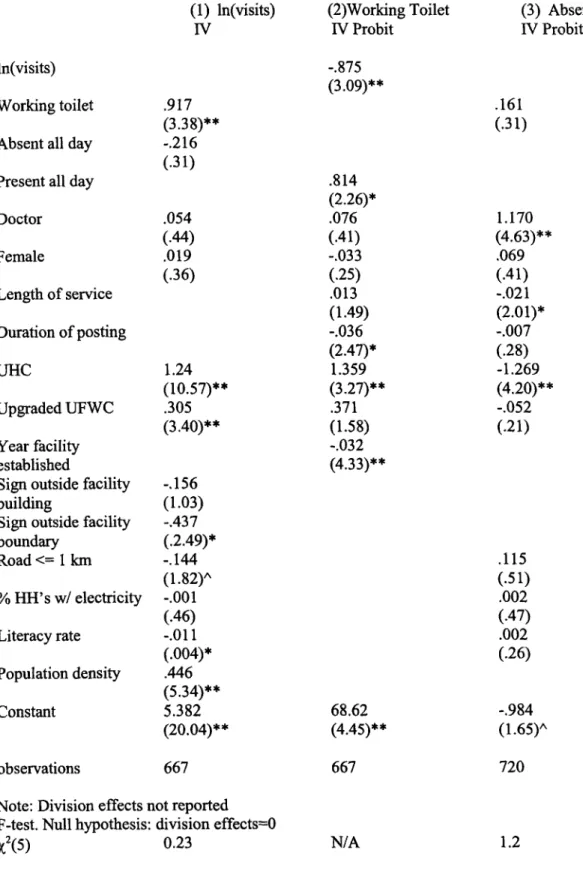klv'5 a 0&
POLICY RESEARCH WORKING PAPER 3 065
Ghost Doctors
Absenteeism in Bangladeshi Health Facilities
Nazmul Chaudhury Jeffrey S. Hammer
The World Bank
Development Research Group Public Services
Public Disclosure AuthorizedPublic Disclosure AuthorizedPublic Disclosure AuthorizedPublic Disclosure Authorized
| POLICY RESEARCH WORKING PAPER 3065
Abstract
Chaudhury and Hammer report on a study in which When separated into level of facility, the absentee rate unannounced visits were made to health clinics in for doctors at the larger clinics is 40 percent, but at the Bangladesh with the intention of discovering what smaller subcenters with a single doctor, the rate is 74 fraction of medical professionals were present at their percent.
assigned post. This survey represents the first attempt to Even though the primary purpose of this survey is to quantify the extent of the problem on a nationally document the extent of the problem among medical representative scale. staff, the authors also explore the determinants of staff
Nationwide the average number of vacancies over all absenteeism. Whether the medical provider lives near the types of providers in rural health centers is 26 percent. health facility, access to a road, and rural electrification Regionally, vacancy rates (unfilled posts) are generally are important determinants of the rate and pattern of higher in the poorer parts of the country. Absentee rates staff absentee rates.
at over 40 percent are particularly high for doctors.
This paper-a product of Public Services, Development Research Group-is part of a larger effort in the group to assess and improve the quality of services for poor people. Copies of the paper are available free from the World Bank, 1818 H Street NW, Washington, DC 20433. Please contact Hedy Sladovich, room MC3-607, telephone 202-473-7698, fax 202- 522-1154, email address hsladovich@worldbank.org. Policy Research Working Papers are also posted on the Web at http://econ.worldbank.org. The authors may be contacted at nchaudhury@worldbank.org or jhammer@worldbank.org.
May 2003. (44 pages)
The Policy Researcb Working Paper Series disseminates the findings of work in progress to encourage the exchange of ideas about development issues. An objective of the series is to get the findings out quickly, even if the presentations are less than fully polished. The papers carry the names of the autbors and sbould be cited accordingly. The findings, interpretations, and conclusions expressed in this paper are entirely those of the authors. They do not necessarily represent the view of the World Bank, its Executive Directors, or the
Ghost Doctors:
Absenteeism in Bangladeshi Health Facilities
Nazmul Chaudhury
Development Research Group, World Bank nchaudhurMalworldbank.org
Jeffrey S. Hammer
Development Research Group, World Bank ihammer(aimworldbank.org
The authors would like to thank Rafiqul Huda Chaudhury, Anil Deolalikar, Jean-Jacques
Dethier, Deon Filmer, Peter Heywood, Hanan Jacoby, Michael Kremer, Lant Prichett,
and Birte Holm Sorensen, for their valuable comments.
I. Introduction
Governments in developing countries spend substantial amounts of money on public services including publicly supplied health care. Nonetheless, dissatisfaction is frequently expressed over the performance and quality of these services'. One possibility is that not enough money is allocated to them, another is that the money is not spent effectively. In this paper we try to quantify one particular way in which public money may not be spent effectively, or at least not the way originally intended. We report on a study in which unannounced visits were made to health clinics in Bangladesh with the intention of discovering what fraction of medical professionals were present at their assigned post.
Absenteeism of public servants from their jobs has been long discussed as an impediment to effective public services particularly in South Asia. In India, a recent report on primary education pointed to absentee rates among head-teachers of
33%2and among all teachers rates so large that actual teaching was being done in less than half the schools visited. That report goes further and reports on gross misbehavior of teachers that do show up for work but pinpoints absenteeism per se as a major problem. In Bangladesh, absenteeism of workers in health clinics has frequently been identified as a particular problem reducing the effectiveness of public spending in health (Sen (1997) and Begum and Sen (1997)). By no means is absenteeism among health and education providers a purely South Asian phenomenon. For example, Glewwe, Kremer, and
ISee
Filmer, Hammer and Pritchett (2000, 2002) for possible ways in which public spending on health may fall short of expectations.
2PROBE
team (1999)
Moulin (1999) find that teachers in one area of Kenya were absent from school 28.4 percent of the time, and in school but absent from their class an additional 12.4 percent of the time. However, neither in Bangladesh nor in other countries have systematic efforts been made to quantify the extent of this problem on a nationally representative scale
3. This gap served as the main motivation for the current study.
Concern over the staffing of facilities in rural areas, specifically, arises both because of the benefits expected from public provision of health care in rural areas as
well as special difficulties that exist in achieving such provision. Public provision of different health services can be justified on grounds that vary with the nature of the service.
4Considerations of equity as well as of correcting externalities associated with communicable disease (itself correlated with poverty
5) argue for extending services to rural areas where the incidence of poverty is much greater than in urban. In a country with as small an urban population as Bangladesh, the majority of the poor are rural as well. There are two problems to confront. One is that many posts do not get filled at all- no provider is willing to accept certain placements. The other is that even when filled, the provider is not there. Both compromise the ability to serve the poor but with different welfare and budgetary implications. Unfilled posts clearly reflect the absence of public medical care but do not absorb budget resources for salary, though upkeep of an un- or under-staffed facility is still required. Absent personnel, on the other hand, still receive
3
Various surveys of health facilities (e.g., survey of health facilities in the Cote d'Ivoire by the Direction de la Statistique to supplement a household survey, as reported in Thomas et al. 1996) and schools (Schleicher et al. 1995) have highlighted the problem of provider absenteeism, however, these surveys were not specifically designed to address this problem (e:g., the questionnaire was administered only to the headmaster without independent verification of information on individual teachers).
4
Since, being both excludable and rivalrous, health care is a private good.
5
Bonilla-Chacin and Hammer, 1999
their salaries. In other contexts, "leakage" from central government expenditures has been documented in the form of monies that do not reach their intended recipientS6. In health and education, a very large proportion of expenditures are absorbed by wages. If public servants are not on the job, the expenditures embodied in them also do not reach
the beneficiaries. On the other hand, in the case of absenteeism, the welfare implication is unclear since services may be delivered by the same personnel in their role as private provider. Assessing the welfare implications of public subsidy for the private provision of
services is beyond the scope of this paper but will be kept in mind as results are interpreted.
Why is staffing rural clinics so difficult? One hypothesis is that most medical practitioners in developing countries generally and in Bangladesh specifically, are urban born and bred, highly educated relative to the population at large, and have skills that are both highly marketable anid lucrative. If married with a family, they are likely to want the same for their children. All together, not the kind of person one would expect to want to live in rural areas. This consideration is most applicable to doctors, of course, but depending on the level of income of the country, would also be true of nurses and paramedics, if to a smaller extent. Chomitz, et. al. (1998) provide evidence that the amount that must be paid to doctors in Indonesia to induce them to live in remote areas is measured in multiples of their current salary.
Since medical skills are marketable and greatly in demand, there is usually a ready opportunity to make money as a private provider outside (and sometimes inside)
6
See Reinikka and Svensson (2001) for an example from Uganda
the public clinic, whether legal or not. So, one problem is to get practitioners to serve in rural areas (certainly to live there, but if they do not live there, to commute) and another to have them forego their private earning potential to provide services in the public facility. Many of the results that follow are consistent with the story that medical personnel have substantial discretion over where and when they discharge their public responsibilities - favoring rich areas and responding to earning ability in the private market.
While we would like to know a great deal more about the reasons for incomplete attention paid to executing work responsibilities, in this paper we start merely by trying to get a general estimate of the extent of the problem. The survey that we have implemented can get at some of the correlates of staff absense (discussed in section IV) but the primary purpose was to focus on the overall magnitude of the problem.
II. Methods
Sampling Procedure
For administrative purposes, Bangladesh is divided into six divisions, 64 districts (Zilas), and 507 sub-districts (Thanas or Upazilas). In rural areas, the Government of
Bangladesh, provides health services through a three tier system. First, there are 376 Upazila Health Complexes (UHCs) that deliver inpatient services and are managed by doctors (medical school graduate
7). The other medical staff in the UHCs are: nurses (4 year training
8); Medical Officers
-paramedics (minimum 3 years training
9); Family
7
UJHCs have been staffed by medical doctors; it is rare for non-Allopathic doctors (e.g., Homeopathic, Unani) to be assigned to public health facilities, however, this policy is currently being revised to bring in non-Allopathic doctors into the public health system.
8
Nurses are only posted at UIHCs (and hospitals)
Welfare Visitors (FWVs) and Senior FWVsl° (minimum 18 month training);
pharmacists"; and lab technicians. Next, there are approximately 1000 upgraded Union Health and Family Welfare Centers (upgraded-UHFWCs) /Rural Health Dispensaries (RHDs) staffed by one doctor, paramedics and family welfare visitors. The present government is planning to increase number of upgraded-UPFWCs by posting doctors and improving facilities. Finally, there are approximately 3000 Union Health and Family Welfare Centers (UHFWCs) managed by paramedics and family welfare visitors. Both types of UHFWCs provide outpatient care. In some areas where government facilities are not functioning, services are provided by NGOs operating one or more static clinics. The government and NGOs also run satellite clinics that are regularly organized by field workers in communities to increase accessibility to health services.
Our survey covered 180 health facilities. The break up of the facilities covered is given in Table 1:
Table 1: Type of health facilities visited In the survey
Upazila Health Complex 60
Upgraded-UHFWC' 30
UHFWC 60
Static Clinic run by NGO 30
We first stratified Upazilas into two categories: Upazilas which are exclusively covered under the Government health system; Upazilas in which a portion of the areas
9 Only
medical doctors and medical officers have the legal authority to prescribe drugs
10 Family welfare visitors are supposed to be primarily involved with reproductive health issues and public health programs such as vaccinalion programs.
" These 'pharmacists' are not pharmacology school graduates, rather have a certification which requires
approximately 18 months of training.
are served by some type of NGO provider. Thirty Upazilas from each of the two strata were selected at random. From each selected Upazila, we randomly selected one UHFWC. Since not every Upazila has an upgraded-UHFWC, we selected 15 upgraded- UHFWC from each of the two strata, one with & the without NGO coverage. While Bangladesh has experienced a mushrooming of NGOs (ranging from provision of medical services to micro-credit to primary schooling), currently very few NGOs provide health services in rural areas with most of the health NGOs being concentrated in urban areas. Since there is no readily available list of NGO health providers operating in rural Bangladesh and there was no way of knowing a priori whether the NGO static clinic was staffed by a doctor, we simply visited the nearest NGO clinic to the Upazila headquarters.
Given that we could not systematically sample NGO health clinics and only 8 out of the 30 static NGO clinics we visited had a sanctioned doctor position, we omit discussion of NGO's in this paper.
Timing
Each sampled facility was visited by a team of trained investigators. The official opening time and closing time of these facilities was 9:00 am and 3:30 pm, respectively.
The availability of doctors and paramedics at the facility was recorded once at
approximately 9:30 am, and again at approximately 2:30 pm. In between that time, the
team collected facility-specific and provider-specific information. There was no
notification of the visit given before the survey team arrived at the facility. The visits to
all the facilities were completed within one month (between mid-March and mid-April
2002).
Survey Instrument
Besides noting the presence of service providers, some key characteristics of the doctors, paramedics, family welfare visitors, lab technician and pharmacist were recorded. From service providers we collected information on age, sex, education, professional training, location of residence, length of service, and duration of posting.
For doctors who were albsent both in the morning and in the afternoon, we had to rely upon information provided by a variety of sources including the Statistical Officer, UHC administrators
12, and other medical staff. Statistical Officers in UHCs usually maintain an updated profile of all medical staff (e.g., information on age, gender, years in service, duration of posting, where the staff resides). The Statistical Officer was present during our visits to all 60 UHCs. In upgraded-UHFWCs, when the only doctor was absent, we had to rely upon information provided by the paramedic. We also collected various facility-specific information (e.g., distance to Upazila headquaters). Besides provider and facility level information, we are collected secondary data on Upazila level characteristics (e.g., % of households in TJpazila with electricity).
III. Descriptive results.
III. A. Which posts are vacant?
Table 2 presents the basic descriptive results concerning the distribution of vacant posts. The first notable result is that, nationwide, the average number of vacancies over
12
Union Health and Family Planning Officer (UHFPO) and Resident Medical Officer (RMO) are the two highest ranking doctors at UHCs, with the chief administrator being the UHFPO.
-7
all types of providers is a very large 26%. Before looking at the problem of attendance, then, it already appears that the problem of providing services in the public sector is severely hampered by the number of people who are willing to take such positions in the first place. The high average percentage of vacant posts is made worse by the wide variation across various dimensions. Regionally, the fraction of such posts is generally higher in the poorer parts of the country. In the richer regions of Dhaka, Khulna and Chittagong, 25% of posts are empty whereas in the poorer regions of Syhet, Rajshahi and Barisal, the average vacancy rate is 31%. When limited to sanctioned doctor posts, the differential increases from 37% for the richer regions to 50% for the poorer.
Across types of providers there is also substantial variation. By far, the greatest proportion of vacant posts are those for doctors, pharmacists and senior Family Welfare Visitors relative to nurses, paramedics and junior FWV's. With the notable exception of paramedics and nurses'
3, this pattern is consistent with the relatively high opportunity cost for being in public service and the related scarcity of such workers for public service.
Gender variation between professions may also play a part, a consideration explored in more detail below.
Different levels of facilities, on the other hand, have no substantial differences in their number of vacant posts. Both upgraded family welfare centers and Upazila health centers have vacancy rates of 40-45% for doctors. The consequences, however, of vacant positions in the two types of facilities are substantially different. A full complement of doctors, for example, in a Upazila health center is 7-9 while there is only one doctor
13
Until recently it was rare for nurses to be engaged in private practice in Bangladesh. However, with the
emergence of private retirement homes, there is a growing demand for nurses in the private sector.
posted per upgraded farnily welfare centers. While there are staff available to substitute for vacant positions in the larger facilities, a vacancy in the upgraded family welfare center means the total lack of availability of a public doctor for that village.
Table 2: Vacancy rates in health facilities
Total 26.2%
Divisions
Dhaka 20.1
Chittagong 32.6
Khulna 25.2
Rajshahi 26.7
Sylhet 37.7
Barisal 30.3
Profession
Doctor 41.0
Nurse 11.1
Paramedic 17.6
Senior FWV 20.4
FWV 4.9
Pharmacist 46.0
Type of Facility
All staff Doctors only Upazila Health Center 23.7 41
Upgraded FWC 24.0 44
m. B. Who shows up for work?
For the purposes of this study, "absenteeism" has a very specific definition.
Facilities are visited at 9:30AM and 2:30 PM. Of the people with sanctioned and filled posts, a staff member is "absent all day" when s/he is at the facility at neither time,
"absent half day" when at the facility at either one or the other time and "present" when
there both times. When an average "absentee rate" is calculated for any group of people, it reflects the average of the value of 1, Y2 and 0 respectively, for each of the providers in the group. So, an absentee rate of 50% could mean that all providers are absent for a half day or that half the providers are absent all day. We do not explore at any depth the reasons for not being at the clinic. However, we do ask if the person is "on deputation" to another post or to training. This category amounted to 2.7% of filled posts. We find that the behavior of those "on deputation" in terms of background variables much more closely mimics the behavior of other absent people rather than those present. For the sake of the calculation of absentee rates, those "on deputation" are considered "absent".
Table 3 shows the basic results concerning staff absence. Several clear patterns
emerge. For the whole sample of providers, the absentee rate is 35%. The variation
around this figure, though, is dramatic. It is clear that professionals are far more likely to
be at work during the official morning hours than in the afternoon. This is not at all
surprising: it is common knowledge that providers use the afternoons to see private
patients. This effect is much stronger among doctors than others. Indeed, the second very
clear result is that doctors have the highest rates of absenteeism - again consistent with
the overall view that the opportunity cost of the providers' time is an important
determinant of public service performance. The irony of this result, though, is that while
doctors are supposed to be at the clinic at the hours the survey teams visited, Family
Welfare Visitors are usually supposed to be visiting families as part of their outreach
duties. It is interesting that their absence from the clinic is so rare. This provides some
empirical credence to the general perception about FWVs, who are specifically recruited
from the local community, that even these providers are often reluctant to deliver services to poor households.
14Table 3: Absentee Rates in Public Facilities
All Providers (%) Doctors Only (%)
Total 35 42.2
Profession
Doctors 42.2
Nurses 27.3
Paramedic 25.0
Senior FWV 30.0
FWV 32.0 -
Pharmacist 28.0
Type of facility
Upazila Health Center 34.4 40.4
Upgraded Family Welfare 37.4 74.0
Center
Family Welfare Center 35.3
Time of day
Morning 15.5 22.7
Afternoon 54.4 61.7
Division
Dhaka 41.7 45.2
Chittagong 33.2 40.3
Khulna 26.5 31.8
Rajshahi 34.4 45.5
Sylhet 29.3 41.7
Barisal 29.0 40.0
Gender
Male (34.5) (40.6)
Female (31.9) (41.7)
Place of Residence
Same as facility 28.0 33.0
Other 39.0 47.8
-
= Not applicable
Note: All differences are signifircant at the 5% level except for those numbers in parenthesis (i.e., Gender)
14
We did not collect any evidence to test another perception about FWVs - that when they do indeed visit
poor households, they often charge for their 'free' services/medicines.
In contrast to the vacancy rates which are higher in poorer areas than richer areas, absentee rates do not show any significant difference between poor and rich areas. Note that when combined with the data on vacancy rates, the "effective" number of public doctors in the poorer regions is much less than government norms would imply. With an overall official coverage rate of 20 doctors per 100,000 people based upon sanctioned doctor positions, applying the vacancy rate of (41%) from our sample, implies a de facto coverage rate of 12 doctors per 100,000 people (furthermore, if we factor in the absentee rate of 42% from our sample, the defacto coverage rate drops to 8.4 doctors per 100,000 people).
One result of potentially great policy significance is the differential between the Upazila health center attendance rates and those of the upgraded family welfare centers.
Recent proposals have been mooted to the effect of increasing the number of upgraded
facilities relative to standard UHFWC's by assigning a doctor to such facilities. As the
table shows, however, the absentee rate of doctors is 40.4% at the higher level facility but
jumps to an astounding 74% in the rural based UHFWC's. If the doctor had
responsibilities outside of the facility such as for home or community visits, this would
be an ambiguous result. But for both facilities, the doctor position does not include such
duties and s/he is supposed to be on site. If it is in fact this difficult to assign doctors to
unattractive posts, the policy which makes this a priority (on "efficiency" or even equity
grounds) needs to be reexamined.
Another very strong result is that practitioners who live within the facility compound or in the village in which the facility is located, are very much more likely to be at work at some time during the day than those that live elsewhere. Among doctors in Upazila health centers, for example, 36% of doctors who live in a different town from the facility do not show up for work at any time during the day in comparison to 13% for those who live in the sarne town. Similarly, only 22% of those living in a different town are present all day in contrast to 43% of those living in the same town. This correlation is to be expected since commuting time and costs should certainly be a barrier to
attendance. On the other hand, the magnitude of the difference is striking.
Finally, absentee rates across gender differ as well though in a way counter to our expectations. Women doctors were absent 41.7% of the time relative to 40.6% for men (this difference, however, in a simple t-test of difference in means was not statistically significant). This can be of policy significance as some women in rural Bangladesh will not be allowed to be seen by male doctors. Differential attendance makes an already skewed availability of medical services away from rural women that much worse. The full story of why female doctors are absent more than men requires the closer
examination that follows.
IV. Exploratory multiva iate analysis
Since this is a one-time survey many questions related to identification and the
direction of causality betwveen variables cannot be answered with certainty. However,
multivariate analysis can throw some light on determinants of provider behavior. The basis of the analysis is an assumption that people will be present at their jobs if it is the best use of their time. The statistical model appropriate for this type of analysis is a multivariate logit estimation procedure based on a random utility model of choice which, by this time, is standard in the literature. The choices are among the alternatives 1) to be present at the assigned post for the whole day, 2) to be there for a half day'
5and 3) to be absent all day. We do not model this with the three categories being ordered since the option of being present for a half day may not be intermediate between the other two options in relevant ways. As will be evident, the choice to be present part time involves different considerations than those of being full time or completely absent.
IV. A. Explanatory variables.
We consider four types of factors that determine the allocation of time during the day: 1) the opportunity cost of time 2) the actual costs (time, money or effort) of getting to work on any particular day 3) the expected sanctions employees can expect if they do not show up for work and 4) employees' internal sense of responsibility towards their public job. Good measures for these variables are not easily available and, in any case, were not obtained in this study. There are several variables, however, that can serve as proxies for the actual determining factors.
Opportunity costs. The basic descriptive statistics reported above hint that at least one major difference in earning capacity is associated with absence - that of being a
15
Given that there were only four cases of being present in the afternoon but not in the morning, these observations dropped from the analysis so that "absent for a half day" and "absent only in the afternoon"
are the same.
doctor versus being any other provider. With over 40% absenteeism, doctors are much less likely to be on the job than other providers, so clearly occupation is an important variable in an explanation of staff absence (Table 3). Indeed, since the overall absence rate of doctors is so much higher than for other practitioners, we will present separate analyses for doctors alone as well as for the entire set.
Besides profession, though, there are other determinants of the opportunity cost of spending time at one's appointed job. One possibility is the length of time that a provider has been at the current location. The longer the tenure, the larger the potential client base from people's familiarity with the provider. Some of the time spent in clinics might be used to cultivate a client base (see Chawla (1996) for an example from India). The use of assistants to steer patients to a doctor's afternoon practice is common. Length of tenure should be positively related to absenteeism, at the least in the form of half day attendance.
Length of service overall, a close approximation to age, is a little more
complicated. While it is possible that with age comes respect and higher fees, older
people in this particular set of facilities may be a distinctive group. Neither the Upazila
health centers nor, certainly, the upgraded family welfare center are particularly
prestigious or desirable ultimate career goals for medical professionals. Much more
desirable are postings in urban areas, either in well-equipped hospitals or in
administrative posts. For a practitioner to be in middle age and still in a relatively low
status position (relative to the rest of the profession) indicates either a particularly
unsuccessful career, perhaps indicating less technical ability, particular dedication to rural service or an idiosyncratic preference to be in rural areas. If the first, we might expect more time on the job given the absence of business opportunities. But we might also expect more time on the job if the provider is more dedicated or simply more comfortable in rural settings. For any of these reasons, we might predict length of time in the profession to decrease absenteeism when length of tenure at the current job is controlled.
How lucrative a private practice is will depend on the wealth of the clientele. We don't have information on the income of the towns and villages in which our providers practice but we can try to approximate it by the fraction of people who have electricity in their homes. The impact is ambiguous even in principle, however, because higher incomes can reflect either higher demand for private services or greater political power to bring to bear on the provider to show up for work in the public clinic. With no information on either political pressure or on the providers' private practice, we will not be able to disentangle these effects.
Earning potential in private practice depends on the reputation of the provider.
Working at a Upazila health center is more prestigious, from the client's perspective, than
working in a primary health clinic and should offer more outside earning opportunities as
well as a larger potential client base for self-referrals. There would be a substantial
premium for private practice for workers at the higher level facility. On the other hand,
since there are more co-workers at the Upazila health center, there are more people
watching one's attendance. For personnel other than doctors, this should be a strong
disincentive for being away from the job, at least for the entire day. Other practitioners provide support services for the doctors and would be expected to be at work whenever the doctor is. Therefore, there are countervailing pressures to be or not be on the job at the higher level facility: greater private earnings but more possible sanctions. On the assumption that being away all day is considered much worse than being away for half the day (increasing marginal cost of "shirking"), the effect of Upazila employment should be to decrease the probability of a full day's absence (particularly for non-doctors) but increase that of a half-day's absence.
Finally, the set of division dummies is included in case there are systematic regional effects. From the descriptive statistics the regional component is important but it is not clear if this is indicative of an independent regional effect or simply captures several of the other determinants included here. In general, there are no strong priors except that the urban centers might provide the best earning opportunities for private practice in ways that are riot otherwise captured by our explanatory variables. In this case, we might expect the effect of being in Dhaka or Chittagong to increase the probability of having a private practice end therefore to be absent at least half the day.
Accessibility of the job. A second set of determinants relate to the cost of reaching the job. We've seen already that living in the village is strongly associated with attendance at the clinic and is readily interpreted as influencing the cost of commuting.
This has such a large effect that we will examine both its impact on absence as well as an
independent analysis of the decision to live in the village. The effect of living in the town
or village will certainly be to decrease absence for the whole day (relative to being present the whole day which is the "left out" category for the multinomial logit estimation procedure). The effect on half-day attendance, however, is ambiguous since a private practice can just as easily be in the same town as farther away.
Another variable related to the costs of reaching work is whether or not there is a road within one kilometer from the clinic. Farther than that requires substantial time and effort in commuting. If people live outside of town, the absence of a road would keep them away from work. This implies an interaction effect between place of residence and accessibility of a road whereby the normally positive impact of living in the village on a full day of service and the normally negative impact of living outside the village are both attenuated by the presence of a road. An interaction variable indicating simultaneously living in the town and having access to a road should have effects opposite to the direct effect of living in the village. We suspect that since commuting in the middle of the day uses up prime working hours, lack of access to a road is most likely to impinge upon getting to a private practice if the practice is in a different location from the public clinic and might expect the effect to be larger for a half-day than for a full day absence.
However, since we don't know where the private practice is located, this is a weak prediction.
Expected sanctions and the sense of responsibility. It is obviously not easy to
find measures of the intensity of supervision nor of non-monetary motivations to attend
to official duties. For sanctions, we have no other indicator besides the influence of
working in a Upazila health center or being in Dhaka, as was already mentioned. Either the peer monitoring from having colleagues at the same facility (for doctors) or the hierarchical monitoring of other professionals by the doctors would lead to more attendance, for at least a half day, in the Upazila health centers. Proximity to the administrative center in Dhaka may also increase the probability of being discovered away from one's post.116 For the sense of responsibility, two available variables are gender, "wealth" as measured by the proportion of households with electricity, and the literacy rate of the village or town. Literacy or income may increase the "voice" with which local concerns are heard by political leaders with the ability to monitor and impose sanctions for inattention to duty. As indicators of income, both electrification and literacy could also increase the demand for private business so the interpretation of this variable will be far from clear. As for gender, in several different kinds of studies, women have been found to be less CorruptI
7and otherwise more rule-abiding. It is possible that gender may lead to better attendance.
IV. B. Regression results
The basic results, for both the entire set of practitioners as well as for the subset of doctors are presented in tables 4a,b and 5a,b. These tables present both the direct estimation results as well as calculations of predicted attendance probabilities given changes in selected variables. The results seem broadly consistent with the calculation of costs and benefits we propose though not in every detail.
16
Readers familiar with Bangladesh may find this discussion refreshingly naive since there isn't really much shame nor probability of formal sanctions associated with being absent but we include this as a possibility anyway.
7
Dollar et. al. (2001), Swami et. al. (2001)
Opportunity costs. For the whole sample, the multivariate analysis reproduces the bivariate result that doctors are much more likely to be absent from work. Controlling for other factors, doctors are likely to be absent for the entire day at a rate of 25% in comparison to 5.7% for other practitioners and likely to be on duty for a half day at a rate of 39.3% in comparison to 41.9% for others. The direct effect of profession, then, is even stronger than sample averages would suggest.
The results also support several of the more "subtle" hypotheses. Consistent with expectations, workers in the Upazila health facilities are much more likely to be absent for a half day than to be either present or absent all day. This is true for both doctors alone as well as for the full sample. The probability of being at one's post for the full day, however, is influenced by postings at the UHC only for the non-doctors. The regression for doctors shows no effect of the type of facility on being absent for the whole day while for the others, the effect is very strong. This is consistent with the view that doctors have more discretion over their work in facilities with many providers than do others who have to answer to the doctors.
The effect of more experienced practitioners, doctors as well as the others, is to
decrease the absentee rate. This is consistent with the "selection" explanation rather than
the market power explanation. Experienced people who are still working in these kinds of
facilities tend to be present for at least part of day though we cannot tell if it due to
greater dedication or lack of alternatives. Duration of tenure at the current post had no
impact in any of the regressions. Developing a private practice appears not to require much investment in time and marketing.
The regional dummies had very little influence except that being in Dhaka region increases the probability of being absent from the facility for a half day (but not for the whole day). This is the same effect as working in a Upazila health center and possibly for the same reason. Dhaka is the most lucrative market for private practice and thus should have more people lurecl away from their posts. Why it is only for a half day has two alternative explanations.. Possibly it is for the sake of market development - either direct self-referral or an indirect effect through reputation. It is also possible that being closer to Dhaka increases ones visibility and the likelihood of supervisory visits. Controlling for region also removes the influence of being a doctor on half-day attendance. This is because of high collinearity of doctors (in posts without vacancies) with the Dhaka division and possibly the ability for all professionals to have outside jobs in Dhaka.
Accessibility of the job. The analysis of the whole sample also reproduces the bivariate result that those living in the village or town are much more likely to be at their official posts. The probability of being absent all day is strongly reduced by being resident in the town as was expected. Residence also decreases the likelihood of attending for a half day, relative to a whole day, though the prior judgment on this was ambiguous.
Private practice can be in the same village or town so living nearby is no impediment to a private practice. This effect is similar in both the full sample as well as for doctors alone.
The decision to live in the town or village of the facility is examined further below.
Table 4A. Multinomial Logit Regression of Absenteeism - Full Sample of Providers
(1) (2) (3) (4)
Absent All Day Half-Day Absent All Day Half-Day
Doctor 2.231 0.455 2.222 0.329
(4.58)** (1.99)* (4.50)** (1.40)
Length of Service -0.048 -0.003 -0.042 -0.000
(2.44)* (0.27) (2.09)* (0.03)
Duration of Posting -0.001 0.013 0.000 0.014
(0.01) (0.58) (0.01) (0.62)
Female 0.080 0.157 0.060 0.061
(0.26) (0.83) (0.19) (0.31)
Lives in Area -2.293 -0.773 -2.293 -0.808
(2.64)** (1.64)^ (2.63)** (1.69)^
Road <= 1 km -0.603 -1.304 -0.525 -1.510
(1.26) (3.49)** (1.07) (3.94)**
Lives*Road 1.363 0.685 1.277 0.707
(1.49) (1.36) (1.39) (1.39)
UHC -2.115 0.427 -2.131 0.576
(3.89)** (1-43) (3.85)** (1.88)^
Upgraded-UHFWC -0.353 -0.340 -0.414 -0.435
(0.79) (1.02) (0.91) (1.27)
% HHs Electricity 0.003 -0.007 0.000 -0.012
(0.39) (1-07) (0.00) (1.84)^
Literacy Rate 0.017 0.007 0.011 -0.007
(1.06) (0.64) (0.62) (0.59)
Dhaka 0.531 1.272
(0.93) (3.38)**
Chittagong 0.352 0.355
(0.59) (0.91)
Khulna -0.787 0.366
(1.10) (0.90)
Sylhet 0.508 -0.066
(0.61) (0.11)
Rajshahi 0.139 0.454
(0.24) (1.21)
Constant -0.182 0.361 -0.187 0.457
(0.20) (0.59) (0.17) (0.62)
Observations 718 718 718 718
Pseudo R2 {Joint Estimation) 0.08 0.10
Log Likelihood -646.28 -630.72
F-tests
HO: i2(5) Division Effects = 0 6.50 24.17**
HO: it(1O)Division Effects = 0 (Joint Estimation} 29.21**
Absolute value of z statistics in parentheses
I significant at 10% * significant at 5%; ** significant at 1%
Note: Reference choice category is 'Present All Day' Left out division is Barisal
Table 4B. Average Predicted Probabilities (%/6) from Multinomial Logit Regression of Absenteeism Full Sample of Providers
Absent All Day Half-Day Present All Day Total
Doctor 25.0 39.3 35.7 100
Non-Doctor Provider 5.7 41.9 52.4 100
9 yrs experience 13.9 41.0
45.1100
21 yrs experience 9.3 43.1 47.6 100
Fernale 12.4 42.3 45.3 100
Male 12.1 41.2 46.7 100
Lives in the Area 7.3 42.0 50.7 100
Doesn't Live in the Area 17.3 41.0 41.7 100
Road <=-1 kmn 13.0 38.4 48.6 100
Road > I krn 9.7 68.9 21.4 100
Lives in the Area & 8.4 39.4 52.2 100
Road <=-1 km
Doesn't Live in the Area & 17.8 37.2 45.0 100
Road <=-1 man
Lives in the Area & 3.0 59.4 37.6 100
Road > 1 km
Doesn't live in the Area & 13.3 67.0 19.7 100
Road > 1 kmn
UHC 8.1 48.1 43.8 100
Upgraded-UHFWC 32.8 19.7 47.5 100
UHFWC 36.9 24.1 39.0 100
Dhaka 12.0 55.2 32.8 100
Chittagong 15.1 35.0 49.9 100
Khulna 6.1 39.1 54.8 100
Sylhet 18.8 25.9 55.3 100
Rajshahi 12.5 38.2 49.3 100
Barisal 12.9 29.1 58.0 100
Table 5A. Multinomial Logit Regression of Absenteeism - Doctor Sample
(1) (2) (3) (4)
Absent All Day Half-day Absent All Day Half-day Length of Service -0.056 -0.009 -0.050 -0.006
(2.36)* (0.51) (2.09)* (0.31)
Duration of Posting 0.057 0.016 0.057 0.048
(0.63) (0.25) (0.59) (0.69)
Female -0.287 -0.117 -0.397 -0.402
(0.61) (0.31) (0.81) (1.00)
Lives in Area -19.522 -1.708 -19.368 -1.071
(54.42)** (0.88) (51.69)** (0.53)
Road <= lkm -0.484 -3.244 -0.274 -3.744
(0.36) (2.27)* (0.20) (2.58)**
Lives*Road 18.529 1.394 18.372 0.886
(.) (0.71) (.) (0.43)
UHC -0.838 2.891 -0.870 3.540
(1.04) (2.18)* (1.03) (2.48)*
% HHs Electricity -0.017 -0.012 -0.020 -0.017
(0.97) (1.26) (1.10) (1.80)^
Literacy Rate 0.006 0.004 -0.002 -0.014
(0.27) (0.24) (0.10) (0.85)
Dhaka 0.097 2.088
(0.14) (2.86)**
Chittagong -0.151 0.717
(0.20) (0.95)
Khulna -1.310 0.999
(1.45) (1.31)
Sylhet 0.280 1.008
(0.26) (1.01)
Rajshahi -0.037 1.355
(0.05) (1.85)^
Constant 1.407 0.669 1.680 -0.199
(0.98) (0.48) (1.03) (0.13)
Observations 321 321 321 321
Pseudo R2 (Joint Estimation) 0.07 0.10
Log Likelihood -310.10 -298.40
F-tests
HO: i2(5) Division Effects = 0 4.26 17.22**
HO: X2(10) Division Effects = 0 (Joint Estimation) 22.30**
Absolute value of z statistics in parentheses
I significant at 10% * significant at 5%; ** significant at 1%
Note: Reference choice category is 'Present All Day' Left out division is Barisal
Table 5B. Average Predicted Probabilities (°/e) from Multinomial Logit Regression of Absenteeism Doctor Sample
Absent All Day Half-Day Present All Day Total
9 yrs experience 24.9 35.6 39.5 100
21 yrs experience 17.0 37.6 45.4 100
Female 19.0 32.9 48.1 100
Male 22.2 38.2 39.6 100
Lives in the Area 12.8 37.3 49.9 100
Doesn't Live in the Area 29.4
35.535.1 100
Road <= 1 kln 24.3, 31.5 44.2 100
Road > 1 krn 10.0 80.2 9.8 100
Lives in the Area & 17.3 32.3 50.4 100
Road <= 1 km
Doesn't Live in the Area & 31.8 30.5 37.7 100
Road <=- 1 kn
Lives in the Area & 0.0 77.3 22.7 100
Road > 1 km
Doesn't live in the Area & 13.0 78.9 8.1 100
Road > 1 kmn
UHC 13.6 50.3 36.1 100
Upgraded-UHFWC 42.3 5.7 52.0 100
Dhaka 19.7 50.3 30.0 100
Chittagong 24.3 25.7 50.0 100
Khulna 9.7 35.0 55.3 100
Sylhet 29.9 28.2 41.9 100
Rajshahi 22.6 36.6 40.8 100
Barisal 29.9 15.2 54.9 100
The effect of being close to a road is to greatly reduce the probability of being present for a half day. This runs counter to our expectations since a road should allow easier access to private practices away from the town of assignment, but again, given that we do not know where private practices are located, the prediction was ambiguous to begin with.
The interaction specification worked almost as expected. While the t-statistics for tests of significance of the coefficient on this variable in each of the equations individually are too low by conventional levels, their joint effect on the pair of equations (whole day and half day absences) taken together was significant at the 5% level. This was true in specifications with and without regional effects. The sign of the coefficient is consistent across the equations and, as hypothesized, has the opposite sign as the coefficient on residence. This means that the presence of a convenient road partially mitigates the effect of living outside of town. Table 4b shows the difference between attendance rates (for a full day) for providers who live in town versus those who do not where there is no road is 17.9% (37.6% - 19.7%). This falls to 7.2% (52.2% - 45.0%) for places where there is a road, indicating ease of access as a partial substitute for proximity of residence.
Expected sanctions and the sense of responsibility. Since these are difficult
variables to measure, perhaps it is not too surprising that the proxies used didn't find
much. As mentioned, the result that attendance at Upazila health centers is high in the
morning hours in spite of the likelihood of better outside earning opportunities may be
related to closer supervision and expectations of attendance in the mornings. For providers other than doctors, better attendance for the whole day in Upazila health centers may be attributable to better supervision by doctors. The direct measures of pressure did not work well. Household electricity (as a proxy for wealth), literacy of the area and whether the provider was female all had no discernable effect. However, they do have an indirect effect through the decision to live in the area of the facility.
IV.C. Determinants of place of residence.
Table 6 shows the results concerning the decision to live in the village or town in which the facility is located. In cross section, this may be a jointly determined effect with the expectation of how often one plans to be at the public job. To start, however, we will consider the decision to live in an area as being made prior to the decision to go to work each day and ignore direct simultaneous effects. The main results, perhaps not surprisingly, are related to characteristics of the town or village of the facility. These variables were included in the absenteeism equations as they could reflect the monitoring power of the community. However, any effect they might have appears to be through the decision to live nearby. The proportion of households with electricity is a strong encouragement for providers to live in the village. This may be due to electricity being a proxy for wealth or it may be the direct benefit of living with access to electricity.
The effect of a road being more than a kilometer away from the facility (and the
village) is to decrease the likelihood that the provider lives in the village as should be
Table 6. Logit Regression of Choice of Residence
Dependent Variable: 1= Lives in the Area ; 0 Otherwise Coefficients are reported as Odds Ratio
(1) (2)
Full Sample Doctor Sample
Doctor 0.921
(0.38)
Length of Service 1.004 1.019
(0.38) (1.15)
Duration of Posting 1.025 1.001
(1.13) (0.01)
Female 0.805 0.507
(1.21) (1.80)^
UHC 0.849 8.179
(0.59) (1.92)^
Upgraded-UHFWC 0.724 (1.09)
Road <= 1 km 1.571 2.642
(1.68)A (1.21)
% HHs Electricity 1.012 1.026
(1.89)A (2.23)*
Literacy Rate 1.002 1.016
(0.18) (0.85)
Population Density 1.304 1.136
(1.21) (0.35)
Dhaka 1.679 0.444
(1.53) (1.44)
Chittagong 2.310 0.790
(2.32)* (0.39)
Khulna 1.144 0.642
(0.35) (0.70)
Sylhet 3.457 1.814
(2.27)* (0.63)
Rajshahi 1.150 0.297
(0.40) (2.11)*
Observations 718 321
Pseudo R2 0.04 10.4
Log Likelihood -478.16 -199.3
F-test
HO: x2(5) Division 16.56** 12.68**
Effects = 0
Absolute value of z statistics in parentheses
^ significant at 10% ; * significant at 5% ; ** significant at 1%
Note: Left out division is Barisal
expected of an indicator of the quality of life. This gives some weak indication that simultaneity is not a serious problem. Had the effect gone the other way, it would imply that people live near their workplace when it is hard to get to, thereby reducing commuting costs. While there may be some such effect, it is dominated by the direct effect of making the town more attractive to live in.
Two variables distinguish doctors from the other providers. First, whether the facility of assignment is a Upazila health center or not distinctly influences doctors but not the other professionals. It appears that doctors simply will not live in villages far away from Upazila headquarters whereas non-doctors are just as likely to live by a family welfare center as a larger facility. Second, the chances that a woman doctor will live in the assigned town oI village are very low. As discussed, an educated woman in Bangladesh will certainly be married (all except four of the 42 female doctors in the sample were married) to an educated man with a career and they will likely live where his job is. This result explaLins the unexpected relationship between low attendance and being female. Conditional on residential location, there is no difference between men and women as far as attendlance is concerned (though, this too was somewhat unexpected).
However, women are much less likely to live nearby.
IV.D. What difference does it make?
In this section we ask whether the absence of health professionals from their
public posts have measurable consequences on other outcomes one might care about. We
cannot claim that the observed absentee rates necessarily imply adverse welfare effects
relative to full attendance. It is possible that being on the public payroll is necessary for professionals to locate outside of metropolitan areas and that while their practice is not provided free in the public facilities, it reaches areas that otherwise would not be served.
Public wages may serve as transfers to the professions that induce more people entering them than would otherwise. While the real world does not play by the rules, it might be that the rules are unrealistic and unduly restrictive. This data does not include any information from households that would help assess overall availability of medical care in geographic areas and we will not be able to assess the full welfare implications of our results empirically'
8.
On the other hand, besides a strong presumption that something is wrong here, the survey did collect information that will let us examine some consequences of the pattern of absences. There are two sets of outcomes that can be tied to the behavior of the providers. First are observations on a set of clinic characteristics that were made by the interviewer. These include subjective judgments about the cleanliness of the facility, the degree of visual and auditory privacy and the adequacy of lighting on one hand and more objective measures such as whether the piped water and toilets at the facility were functional. A simple hypothesis is that professionals who are regularly at their assigned post will look after these characteristics of the facility and keep it in generally good repair. Results of simple regressions of each of these indicators on absence controlling for
18
Current work by Abhijit, Deaton and Duflo (2001) in Rajasthan state in India is designed to better
address welfare implications.
a set of likely other determinants are summarized in table 7.19 In general, staff absence has a strong effect on these various indicators of the condition and functioning of the facility.
Table 7. Staff absence and facility maintenance Absent full day Absent half day
Cleanliness NS
*Visual privacy
* **Auditory privacy
* **Functional piped water
**NS
Functional toilet
** **(Entries are the significance level of the coefficients on absenteeism from a regression for the indicator at left. All significant coefficients had the correct, negative, sign indicating that absenteeism hurts all indicators. The other variables in the equation can be found in Table 8)
NS = not significant * = significant at 5% ; **= significant at 1%
The other outcorme of interest is the use of the facility by patients. The interviewer was instructed to look at the roster sheet of intake of the facility over the past week and note the numbers of patients visiting the facility. The absence of professionals, particularly of doctors, has often been noted as a cause of low utilization of facilities.
This might be through the direct effect of the desire to see a doctor, or through an indirect effect of the attractiveness of visible characteristics of the facility.
19
The unit of observation in these regressions, as in all that follow, is a person rather than a facility. The
interpretation is whether a provider is likely to be serving in a facility with a certain level of maintenance
conditional on his own characteristics as well as of the facility and community.
Unfortunately, the condition of the facility and the number of patients are almost certainly determined simultaneously. The better maintained the facility, the more users it will attract. The more heavily a facility is used, the more wear and tear (and lack of visual and auditory privacy) it will have. While these effects may seem remotely related to absenteeism, if they are simultaneously determined they will bias the estimated results of absenteeism on either of them. The direction of bias is such that it will reduce the probability of finding an effect of absenteeism with single equation techniques.
20The determinants of the demand for services and the physical condition of facilities are likely to be sufficiently distinct that there is some hope of identifying the structural relationships. The determinants of demand that we can get out of the survey are: community characteristics of electricity and literacy, distance of a facility to a road, population and physical area of the Upazila (for the geographic concentration of the population), regional effects, the type of facility, whether the facility is well marked by signboards21 as well as a measure of physical condition and absenteeism of doctors and other staff. For tractability of the estimation only one indicator of "maintenance" was
20
Demand for services (D) is detennined by absenteeism (A), quality of maintenance (M) and a set of other determinants (call them "income (Y)"). Maintenance is deternined by absenteeism, the level of demand (due to wear and tear) and a set of other variables (call them "age of the facility (F)"). The relations we are interested in (with el and
82being error terms) are:
D=a
+bA
+cM
+dY
+M=a
+A + yD
+8F
+82The reduced form of these relations has as the coefficient of the variable for absenteeism on demand and maintenance respectively: (b+pc)/(1-yc) and (3 + yb)/(1-yc). If the effect of maintenance on demand, c, is positive and the effect of demand on maintenance, y, is negative, the coefficient of absence on maintenance will be much lower than the direct effect, P, and the coefficient of absence on demand will differ from the direct effect, b, in an undetermined direction but will be lower if y is large. Therefore, without estimating the structural equations, we are likely to underestimate the effects of absenteeism on these outcomes.
21
